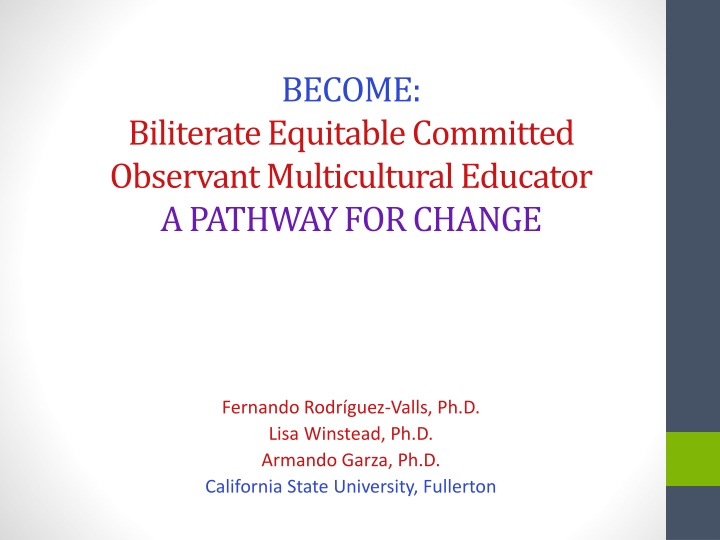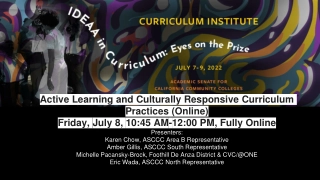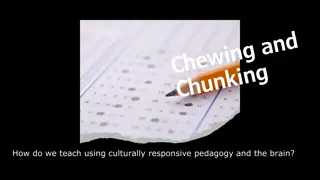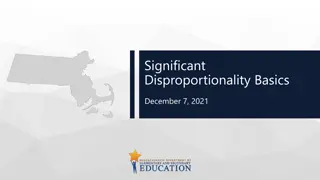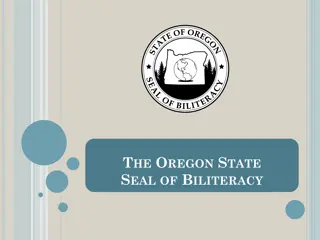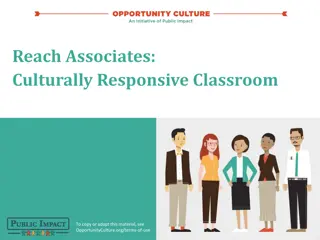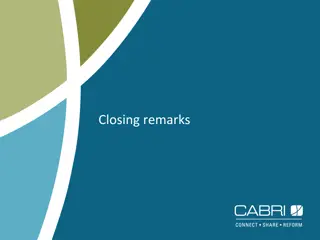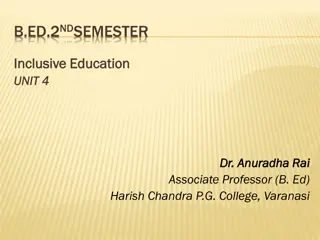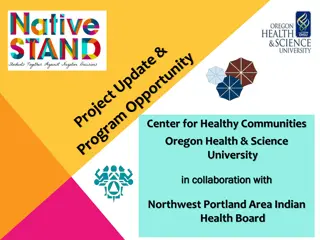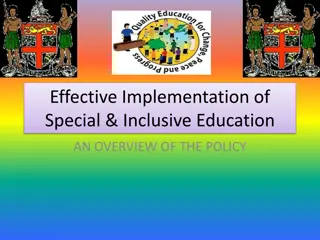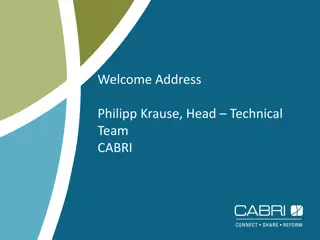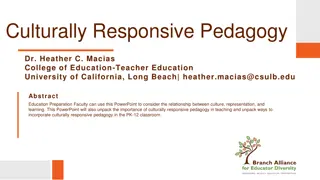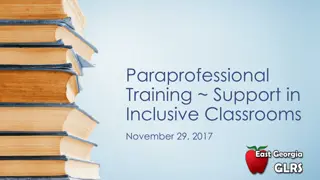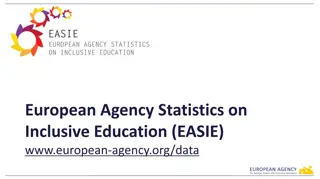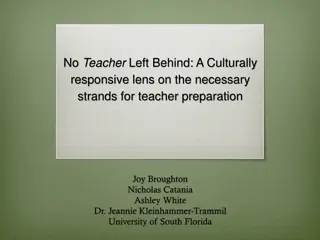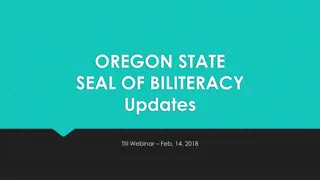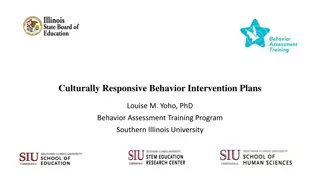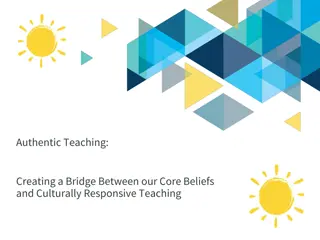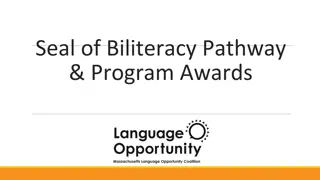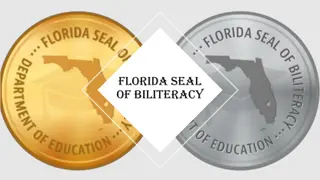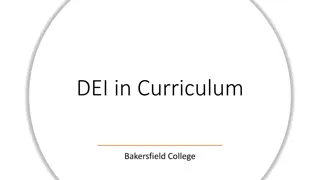Culturally Responsive Biliteracy in Inclusive Education
Culturally responsive biliteracy in inclusive education emphasizes the importance of teaching in two languages, valuing diverse cultural and linguistic identities, and creating a participatory and inclusive classroom environment. Educators play a crucial role in fostering language development and acquisition while ensuring every student feels included and empowered to engage critically with linguistic aspects. The commitment to equity and cultural enrichment enhances students' global citizenship and promotes a community of learners who celebrate linguistic diversity.
Download Presentation

Please find below an Image/Link to download the presentation.
The content on the website is provided AS IS for your information and personal use only. It may not be sold, licensed, or shared on other websites without obtaining consent from the author.If you encounter any issues during the download, it is possible that the publisher has removed the file from their server.
You are allowed to download the files provided on this website for personal or commercial use, subject to the condition that they are used lawfully. All files are the property of their respective owners.
The content on the website is provided AS IS for your information and personal use only. It may not be sold, licensed, or shared on other websites without obtaining consent from the author.
E N D
Presentation Transcript
BECOME: BiliterateEquitable Committed Observant Multicultural Educator A PATHWAY FOR CHANGE Fernando Rodr guez-Valls, Ph.D. Lisa Winstead, Ph.D. Armando Garza, Ph.D. California State University, Fullerton
BILITERACY PK-16 BILITERATE BICULUTURA L WORK FORCE LONG TERM COMMUNITY COMMITMENT BILITERACY
BECOME Commitment Sensitivity Preparation
A committed, engaged pedagogy fuels the engine of an inclusive classroom The concept of the committed and engaged pedagogy visualizes every student as an active participant in the language development/acquisition processes (hooks, 2010) The new classroom in which languages coexist and students learn a second language is a classroom that functions as a learning cooperative (Gavil n Bouzas and Alario S nchez, 2014) We have to help the student grow and develop as a global citizen, prepared to enrich their culture and language with new cultures and new languages (Garc a, 2009; Grosjean & Li, 2013).
Inclusive Education With a partner create an acronym that explains how you define inclusive education I N C L U S I V E
Culturally and linguistically responsive methodology Which language(s) should be taught in the classroom? In the inclusive classroom, the teacher teaches the target language and in the target language, using the language as a tool through which the student analyzes in a critical way the linguistic aspects that connect and differentiate himself/herself from their classmates. The student has the right to have their cultural and linguistic identity not only valued but also utilized to contextualize and enrich the learning processes (Nieto, 2013). [activities and strategies] focus on and respond to the positive and unique cultural [linguistic] experiences that children and their families contribute to the school community educators need to strive for excellence and must be able to design meaningful [activities] and stimulating academic environments Biliteracy in the classroom, the WE space 1. 2. 3.
Language(s) Proficiency(ies) Teaching in two languages calls for teachers who know how to communicate in personal and intellectual ways. The way teachers use the classroom discourse has a direct impact when constructing a participatory and inclusive classroom environment. Teaching in two languages is an expression of equity, which goal is to critically analyze the role languages and their registers play within different contexts. Ultimately, the goal is to read the word and the worlds with biliterate, critical eyes.
Bilingual Authorization Language Emphasis Engaged Methodology Cultural Responsive Practice Culture and Education of Latino Students Language Proficiency Spanish Methods and Inquiry for Bilingual Teachers Oral and written exam at CSUF EDSC 446 Methods and Inquiry for Bilingual Teachers EDSC 541 Culture and Education of Students Mandarin, Korean and Vietnamese CSET LOTE III in the target language EDSC 446 EDSC 541
Why Spanish Bilingual Authorization in Multiple Subjects (Elementary Ed)? Opportunity to become part of a community and networking with other Spanish bilingual educators who desire to teach in dual immersion or bilingual programs Full time classes during the day during initial weeks as well as fieldwork, then Gaining semester to year-long bilingual student teaching experiences in dual immersion/bilingual classrooms Bilingual Authorization courses may need to be taken in summer
Spanish Bilingual Authorization in the Dept. of Elementary and Bilingual Ed. Generally two semesters Two additional courses beyond the Multiple Subject Credential EDEL/EDSC 446 EDEL/EDSC 541 Student teaching in dual immersion classroom for up to 2 semesters Building and support of ongoing development of Spanish literacy and instruction
To Obtain a Spanish Bilingual Authorization in Dept. of Elementary & Bilingual Education Bachelor s Degree or Completion of GE requirements with no more than 6 units remaining in your major Admission into Multiple Subject Credential Program
Gracias / Thank you / / Salamat / / c m nb n Fernando Rodr guez-Valls- COE Bilingual Authorization Program Coordinator: frodriguez-valls@fullerton.edu Lisa Winstead- Spanish Bilingual Authorization Coordinator, EDEL lwinstead@fullerton.edu Armando Garza- Spanish Bilingual Authorization Outreach, EDEL agarza@fullerton.edu No one is born fully-formed: it is through self-experience in the world that we become what we are Paolo Freire
